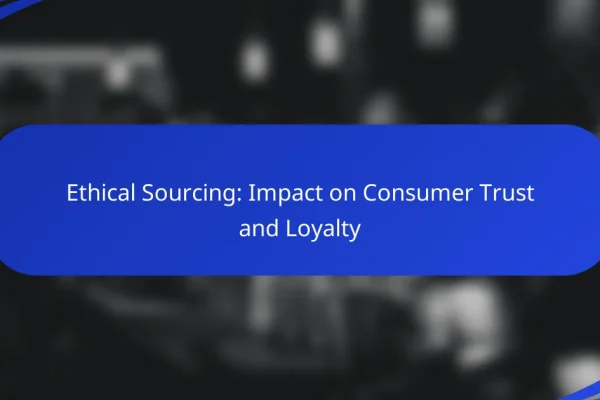How can sourcing transparency improve e-commerce?
Sourcing transparency can significantly enhance e-commerce by building trust with consumers and ensuring a more reliable supply chain. By providing clear information about product origins and manufacturing processes, businesses can foster customer confidence and mitigate potential risks.
Enhances customer trust
When e-commerce businesses are transparent about their sourcing practices, customers feel more secure in their purchasing decisions. Knowing where products come from and how they are made can alleviate concerns about quality and ethical standards.
For instance, brands that disclose their supply chain details, such as fair labor practices and sustainable sourcing, often see an increase in customer satisfaction. This trust can lead to positive reviews and repeat purchases, which are crucial for long-term success.
Reduces supply chain risks
Sourcing transparency helps businesses identify and address potential vulnerabilities within their supply chains. By having clear visibility into every step of the process, companies can quickly respond to disruptions, such as delays or quality issues.
For example, if a supplier is found to be non-compliant with regulations, a transparent sourcing strategy allows a business to pivot to alternative suppliers without significant downtime. This proactive approach can save costs and maintain operational continuity.
Increases brand loyalty
Customers are more likely to remain loyal to brands that demonstrate ethical sourcing practices. When consumers feel aligned with a brand’s values, particularly regarding sustainability and social responsibility, they are inclined to support it over competitors.
To cultivate this loyalty, e-commerce businesses should consistently communicate their sourcing efforts and achievements. Engaging storytelling about sourcing practices can resonate with consumers, encouraging them to become brand advocates and share their positive experiences.
What are the best practices for sourcing transparency?
Best practices for sourcing transparency involve implementing systems that allow for clear visibility into the supply chain, ensuring ethical practices, and maintaining open communication with stakeholders. These practices help build trust and accountability among consumers and suppliers alike.
Implementing traceability systems
Traceability systems enable companies to track the origin of their products throughout the supply chain. This can involve using technologies such as blockchain or RFID to document each step, from raw material sourcing to final delivery. By establishing a robust traceability system, businesses can quickly identify and address any issues related to sourcing.
Consider adopting industry standards like GS1 for product identification and data sharing. This can enhance efficiency and ensure compliance with regulations, particularly in sectors like food and pharmaceuticals where safety is paramount.
Regular supplier audits
Conducting regular audits of suppliers is crucial for maintaining sourcing transparency. These audits assess compliance with ethical standards, quality control, and environmental regulations. Scheduling audits at least annually can help identify potential risks and areas for improvement.
When planning audits, use a checklist that includes key performance indicators such as labor practices, sustainability efforts, and product quality. This structured approach ensures that all critical aspects are evaluated consistently.
Clear communication of sourcing policies
Clear communication of sourcing policies is vital for transparency. Companies should openly share their sourcing criteria, ethical standards, and any certifications with consumers and stakeholders. This transparency fosters trust and encourages responsible consumer behavior.
Utilize various platforms, such as websites, social media, and product packaging, to communicate these policies effectively. Regular updates on sourcing practices can also keep stakeholders informed and engaged, reinforcing the company’s commitment to transparency.
Which companies excel in sourcing transparency?
Several companies are recognized for their commitment to sourcing transparency, providing clear insights into their supply chains and production practices. Notable examples include Patagonia, Everlane, and Uncommon Goods, each adopting unique strategies to ensure ethical sourcing and consumer awareness.
Patagonia
Patagonia is a leader in sourcing transparency, known for its dedication to environmental and social responsibility. The company openly shares information about its supply chain, including details about factories, materials, and labor practices.
Patagonia uses a comprehensive approach, offering customers access to the Footprint Chronicles, which allows them to trace the journey of their products. This commitment not only builds trust but also encourages consumers to make informed choices about their purchases.
Everlane
Everlane prioritizes radical transparency in its sourcing practices, revealing the true costs behind its products. The company discloses information about factories, production processes, and pricing, allowing customers to understand where their money goes.
By providing detailed breakdowns of costs and sourcing locations, Everlane empowers consumers to make ethical decisions. Their “Choose What You Pay” model further enhances transparency by allowing customers to select their price based on their understanding of product value.
Uncommon Goods
Uncommon Goods stands out for its commitment to sourcing transparency, particularly in its selection of handmade and unique products. The company emphasizes ethical sourcing by collaborating with artisans and small businesses, sharing their stories with customers.
Uncommon Goods provides detailed information about the origins of its products, including materials and production methods. This transparency not only supports small-scale producers but also helps consumers appreciate the craftsmanship behind each item.
What tools can help achieve sourcing transparency?
Several tools can enhance sourcing transparency, enabling businesses to track their supply chains more effectively. Key technologies include supply chain management software, blockchain technology, and data analytics platforms, each offering unique capabilities to improve visibility and accountability.
Supply chain management software
Supply chain management (SCM) software helps organizations manage and optimize their supply chain processes. These tools provide real-time data on inventory levels, order statuses, and supplier performance, allowing companies to make informed decisions quickly.
When selecting SCM software, consider features like integration capabilities, user-friendliness, and scalability. Popular options include SAP SCM, Oracle SCM Cloud, and Microsoft Dynamics 365, which cater to various business sizes and needs.
Blockchain technology
Blockchain technology offers a decentralized and secure way to track products throughout the supply chain. By creating an immutable ledger, blockchain enables all parties to verify the authenticity and origin of goods, enhancing trust among stakeholders.
Implementing blockchain can be complex and may require significant investment in infrastructure and training. However, companies like IBM and VeChain provide platforms that simplify integration, making it easier for businesses to adopt this technology.
Data analytics platforms
Data analytics platforms analyze vast amounts of supply chain data to identify trends, inefficiencies, and risks. These insights help organizations improve sourcing decisions and enhance overall supply chain performance.
When choosing a data analytics platform, look for tools that offer predictive analytics, visualization capabilities, and integration with existing systems. Examples include Tableau, Microsoft Power BI, and Qlik, which can help businesses turn data into actionable insights.
How does sourcing transparency affect pricing?
Sourcing transparency can significantly impact pricing by influencing consumer perceptions and supplier costs. When companies disclose their sourcing practices, it often leads to higher operational expenses, which may be reflected in the final price of products.
Potential for higher costs
Increased sourcing transparency often leads to higher costs for businesses. Companies may need to invest in ethical sourcing practices, such as fair labor conditions and sustainable materials, which can raise production expenses. For example, sourcing organic cotton instead of conventional cotton may increase costs by 20-30%.
Additionally, companies may face higher compliance costs associated with regulations and certifications that ensure transparency. These costs can ultimately be passed on to consumers, resulting in higher retail prices.
Value-driven pricing strategies
On the other hand, sourcing transparency can enable value-driven pricing strategies that appeal to conscious consumers. Brands that prioritize ethical sourcing can differentiate themselves in the market, allowing them to charge premium prices. For instance, a brand that sources fair-trade coffee may justify a higher price point due to its commitment to ethical practices.
Moreover, transparent sourcing can foster customer loyalty and trust, which can lead to increased sales over time. Companies should consider communicating their sourcing practices clearly to enhance perceived value and justify any price increases.
What are the challenges of achieving sourcing transparency?
Achieving sourcing transparency involves navigating several significant challenges that can hinder visibility into supply chains. Key obstacles include complex supply chains, resistance from suppliers, and data privacy concerns.
Complex supply chains
Complex supply chains often involve multiple tiers of suppliers, making it difficult to trace the origin of materials and components. Each additional layer can obscure visibility, leading to challenges in ensuring ethical sourcing practices.
To manage complexity, companies should map their supply chains thoroughly and establish clear communication channels with all suppliers. Utilizing technology, such as blockchain, can enhance traceability and provide real-time data on sourcing practices.
Resistance from suppliers
Suppliers may resist transparency initiatives due to concerns about competitive advantage or fear of scrutiny. This resistance can manifest as reluctance to share information about sourcing practices or production processes.
Building strong relationships with suppliers is crucial. Companies should engage suppliers in discussions about the benefits of transparency, such as improved brand reputation and customer trust, to encourage cooperation.
Data privacy concerns
Data privacy concerns can complicate sourcing transparency, especially when sensitive information about suppliers or proprietary processes is involved. Companies must balance the need for transparency with the obligation to protect confidential data.
Implementing robust data management policies and utilizing secure platforms for information sharing can help mitigate these concerns. Organizations should also stay informed about relevant regulations, such as GDPR, to ensure compliance while pursuing transparency goals.






